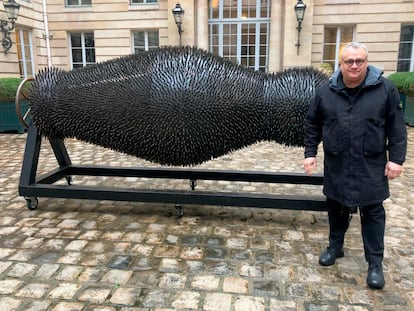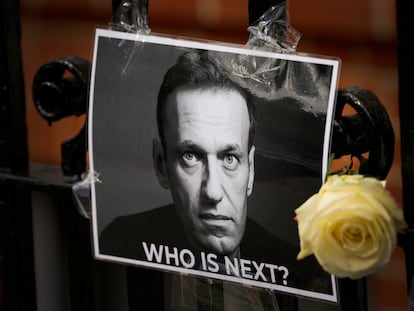Ukraine’s most famous sculptor turns war debris into art, expressing the inexpressible
Mikhail Reva has not rested in transforming over two tons of war debris — spiked Kalashnikov cartridges, bullets and arresting crumpled shells — into art that expresses his homeland’s suffering

From within the debris of Russia’s war, Ukraine’s most famous sculptor was compelled to make a dark artistic pivot the day his own country house was ravaged by a Russian strike.
“It happened by accident, it happened when a missile came into our house, our dacha … and my neighbors gathered the debris from the missile,” Mikhail Reva said, via a translator. “And the idea came to my mind to make a metaphor of those debris.”
Two years into the invasion, the Odesa native has not rested in transforming over two tons of war debris — spiked Kalashnikov cartridges, bullets and arresting crumpled shells — into art that expresses his homeland’s suffering. The often monumental sculptures serve as challenging and emotional reminders of the vital role of art to express the inexpressible.
The wrought iron works, some with delicate wings, others religious and ironic, are on display in the U.S. Embassy’s storied Hotel de Talleyrand in Paris, as part of an initiative by the United States to reengage with the Paris-based U.N. cultural agency, UNESCO, which it rejoined last year after a years-long hiatus. It’s also an effort to highlight important voices in the war which has seen a loss of life on an unimaginable scale.
“In any long war you can get complacent, and art has the power to transcend, to make you stop and make you remember it’s about individuals,” said Jean Manes, the chargé d’affaires for the U.S. Mission to UNESCO. “It has the ability to make you see it again, see it with fresh eyes.”
Compelled to transform the incomprehensible destruction into something meaningful, Reva created 2023′s “The Flower of Death,” utilizing rocket fragments from the actual strike on his house.
“As an artist, it was quite challenging for me when I learned about the attack on the dacha to understand how I can translate the pain in my artistic method. It was the big question,” he said.
Reva was famous long before his art took a darker turn. His famously whimsical sculptures have been seen by millions and in prominent squares and beaches in Odesa, Kyiv and beyond. However, the relentless conflict has compelled his artwork to narrate a more sinister tale — one of endurance and remembrance amid the atrocities of the conflict.
The Memory of the Crucified, stands out in the collection, its form a cross composed of nails recovered from churches obliterated by Russian attacks. This piece, along with Aggressor, a boldly sexualized sculpture featuring a missile provocatively positioned, captures the profound essence of defiance against aggression.
Meanwhile, a gargantuan Russian doll, subtitled From Russia With Love and adorned with 1,000 bullet cartridges as spikes, embodies the irony of violence.
“I see (the materials) as something that humanity has created to take somebody’s life ... I wanted to show that I can make something beautiful from something that was made to kill,” he added.
Reva, with a touch of humor, noted, “All of these pieces are from Russia with love.”
There are plans to display the sculptures to the public in the city halls of Paris’ 3rd and 15th districts later this month.
Sign up for our weekly newsletter to get more English-language news coverage from EL PAÍS USA Edition
Tu suscripción se está usando en otro dispositivo
¿Quieres añadir otro usuario a tu suscripción?
Si continúas leyendo en este dispositivo, no se podrá leer en el otro.
FlechaTu suscripción se está usando en otro dispositivo y solo puedes acceder a EL PAÍS desde un dispositivo a la vez.
Si quieres compartir tu cuenta, cambia tu suscripción a la modalidad Premium, así podrás añadir otro usuario. Cada uno accederá con su propia cuenta de email, lo que os permitirá personalizar vuestra experiencia en EL PAÍS.
¿Tienes una suscripción de empresa? Accede aquí para contratar más cuentas.
En el caso de no saber quién está usando tu cuenta, te recomendamos cambiar tu contraseña aquí.
Si decides continuar compartiendo tu cuenta, este mensaje se mostrará en tu dispositivo y en el de la otra persona que está usando tu cuenta de forma indefinida, afectando a tu experiencia de lectura. Puedes consultar aquí los términos y condiciones de la suscripción digital.
More information
Archived In
Últimas noticias
Most viewed
- Oona Chaplin: ‘I told James Cameron that I was living in a treehouse and starting a permaculture project with a friend’
- Reinhard Genzel, Nobel laureate in physics: ‘One-minute videos will never give you the truth’
- Sinaloa Cartel war is taking its toll on Los Chapitos
- Why the price of coffee has skyrocketed: from Brazilian plantations to specialty coffee houses
- Silver prices are going crazy: This is what’s fueling the rally










































